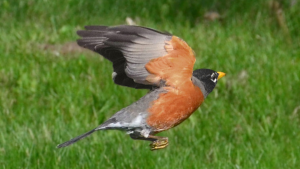About Falcons
8 Flight
Lauren Weiss
Peregrine falcons are the fastest animal on Earth. They can reach diving speeds of over 240 miles per hour. That’s faster than a car in the Indianapolis 500! Their regular flying speed is usually between 40-60 miles per hour.
How Do Birds Fly?
There are several reasons many birds are able to fly. Aside from their streamlined body and body shape (including lightweight, smooth feathers), birds have bones that are full of holes (on purpose!). People used to think that hollow bones were lighter and that allowed birds to fly, but we now know that is not the case. The truth is that the crisscrossed nature of the holes makes the bones denser, stiffer, and stronger, and those holy spaces in the bones have air sacs attached inside, extending from their lungs. This allows more oxygen to flow through the body, which gives the birds the energy they need to fly.

Of course, not all birds are able to fly, so what sets a falcon apart from an ostrich? It’s all in the keel! A bird’s wing muscles are attached to a keel, an extension of the sternum (breastbone) that acts like an anchor for those muscles. Flightless birds like ostriches don’t have keels, so they lack the power required to get them off the ground.
Now, how do birds deal with gravity? Gravity is a force that pulls things towards each other. Earth’s gravity pulls things towards Earth, which is why when you jump up, you come back down. Birds are able to counteract gravity with another force called lift. Lift is an upward force where air moves faster over the top of a bird’s wing and slower under the bottom of the wing. This means that air pressure is lower over the top of the wing. Since air automatically goes to places with lower pressure (like when you deflate a balloon and the air comes out of it fast), the air moves from over the top of the wing to underneath it, which pushes the bird up.
Wing Shapes
There are 5 general types of bird wings: passive soaring wings, active soaring wings, elliptical wings, high-speed wings, and hovering wings.
Passive Soaring Wings

Passive soaring wings are wings with long primary feathers that spread out so hot air can get through and help the birds fly higher. Bald eagles have passive soaring wings.
Active Soaring Wings

Active soaring wings are long and narrow so birds can soar (fly without flapping their wings) for a long time; these birds depend on wind currents more than birds with passive soaring wings. Seagulls have active soaring wings.
Elliptical Wings

Elliptical wings are rounded/oval-shaped. They are good for flying fast for short amounts of time, but can’t keep up that high speed for too long. Elliptical wings also allow for fast takeoffs and tight maneuvering. American robins have elliptical wings.
High-Speed Wings

High-speed wings are long, thin, and pointed (but not as long as active soaring wings). They allow a bird to fly very fast and keep up the high speed for a while. Peregrine falcons have high-speed wings.
Hovering Wings

Hovering wings are small and quick. The nerves and muscles of birds with hovering wings are specially adapted to move very fast, as well. Hummingbirds have hovering wings.
How Do Peregrine Falcons Fly So Fast?
Keel
Peregrine falcons have very large keels. The larger the keel, the more muscles and flapping power a bird has, and the faster it is able to fly.
Wing Shape
Peregrine falcons have high-speed wings that are swept back and have slim, stiff feathers. This makes them more streamlined and more aerodynamic, which means they have less drag (a force that slows down the movement of an object when it passes through a liquid or a gas). It’s like how bicyclists wear tight sports clothing made of special materials so they can go faster than they would if they were wearing loose, regular clothing.
Anatomy
 Peregrine falcons have highly efficient respiratory and circulatory systems. They have a one-way air flow into their lungs with air sacs that keep their lungs inflated even when exhaling, which allows them to breathe when they reach very high speeds. They also have a strong heart. A peregrine falcon’s heart beats between 600 and 900 times per minute. This allows it to keep the oxygen traveling through its body very quickly so it doesn’t get tired as quickly. It also allows the falcon to flap its wings up to four times per second.
Peregrine falcons have highly efficient respiratory and circulatory systems. They have a one-way air flow into their lungs with air sacs that keep their lungs inflated even when exhaling, which allows them to breathe when they reach very high speeds. They also have a strong heart. A peregrine falcon’s heart beats between 600 and 900 times per minute. This allows it to keep the oxygen traveling through its body very quickly so it doesn’t get tired as quickly. It also allows the falcon to flap its wings up to four times per second.
Media Attributions
- Bird Keel © Toony is licensed under a CC BY-SA (Attribution ShareAlike) license
- Passive Wings_raptor-3079603_1920 Bald Eagle © Pixabay is licensed under a CC0 (Creative Commons Zero) license
- active wings_bird-2444497_1920 Seagull © Pixabay is licensed under a CC0 (Creative Commons Zero) license
- Elliptical Wings Smaller File Photo 1920 x 1080 px © Pixabay is licensed under a CC0 (Creative Commons Zero) license
- High Speed Wings © Micheal Pociecha is licensed under a CC BY-SA (Attribution ShareAlike) license
- Hovering Wings_hummingbird-2139279_1920 © Pixabay is licensed under a CC0 (Creative Commons Zero) license
- Falcon Skeleton Respiratory System © Chloe Deeley is licensed under a CC BY (Attribution) license

